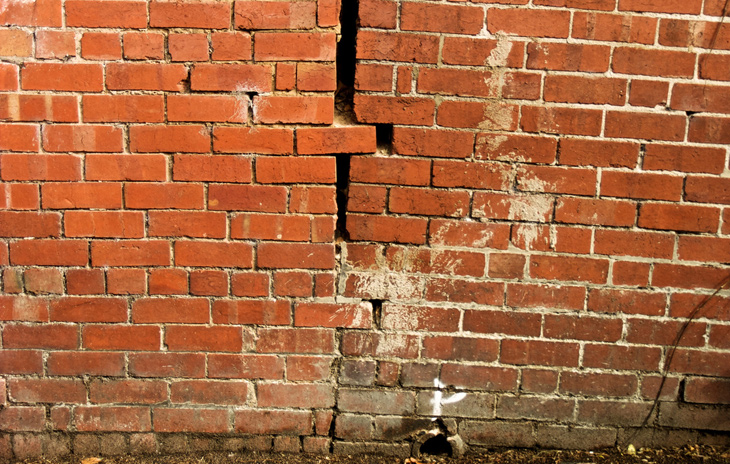How to Repair Cracks in Masonry
by siteadmin

Brick masonry takes a beating from sunlight, rain and ice. Many of these effects show up as cosmetic cracks in the mortar joints, which can easily be repaired.
It's important to use the proper repair materials in repairing cracks in masonry. Using high-strength modern epoxies to repair historic masonry can cause stress concentrations and change the way moisture vapor passes through the wall, hastening deterioration.
Tuck Pointing
Tuck pointing involves replacing the deteriorated mortar in brick walls to prevent water from entering and damaging the masonry. A skilled mason can blend the new mortar with the existing bricks so that a casual observer can’t even tell where the repair was made. This makes tuck pointing a more precise and involved job than simply refreshing the mortar.
To tuck point, the mason first whisks away any loose debris in the mortar joint with a brush. Then he or she mixes a bit of water into the mortar mix to make it moist enough to work with. The mason then applies a small amount of the new mortar to the edge of the mortar joint with a trowel or masonry hawk. Then he or she uses the tool to cut a thin channel into the newly applied mortar and fills it with a contrasting color.
The contrasting colors create the illusion of very thin joints in the brickwork. This gives a refined and elegant look to your brick home or business. As the mason works, he or she must be careful to match the color of the new mortar with the surrounding bricks. This is the most time-consuming aspect of tuck pointing.
Vinyl Concrete Patch
If the cracks in your masonry wall are accompanied by a loss of mortar, or if they are wider than a quarter inch, it is best to use a vinyl concrete patch. This material is designed to bond with existing concrete and prevent additional cracking of the masonry.
This product is available at most home improvement centers and is easy to use. It is recommended that you clean the surfaces to be repaired and dampen them before applying the product. It is also important to make sure that you use a backer rod for the narrow cracks; this will help ensure that the patching cement does not rip away from the concrete wall.
Mix the concrete repair material with water to a soupy consistency, and smear it into the crack or hole using a gloved hand or rag. Some patches come pre-mixed with sand or grit, so you can just start troweling to get a smooth finish.
Filling Cracks in the Mortar Joints
Over time, bricks and mortar crack. This is a normal part of the building process and is usually caused by freezing and thawing soil and expansion/contraction of masonry. The cracks can be repaired in several ways.
First, the bricks must be inspected and cleaned of any loose debris. You can use a hammer and chisel to do this or a wire brush. Next, the mortar joints should be filled. This can be done with a mortar mix, a pointing tool or a rake. The mortar should be raked out to the same depth as the surrounding bricks.
Stitching is a technique used when large cracks occur in load-bearing walls of masonry buildings. It involves a temporary support system being fixed to the wall, and this is then filled with concrete or cement mortar. This method can help to strengthen the wall, but it is important that a structural engineer assesses the structure before stitching work is carried out.
Sealing Cracks
Sometimes a brick wall crack is due to a serious structural issue, and in this situation the best course of action may be to call in a structural engineer. However, if the problem is simply a cracked surface that needs some attention, a professional can often offer an affordable solution.
For cracks that do not penetrate the mortar joints but rather just the masonry itself, a simple masonry repair product can be used to fill the cracks and make the area look new again. Ensure that the crack is cleaned thoroughly prior to applying the sealant, removing any loose bits of brick and cleaning out any fine particles.
Be sure to use appropriate safety measures for handling cement products, including wearing protective clothing and using respirators to avoid eye and lung damage. For the most durable results, always leave tuck pointing and other masonry repairs to professionals who have experience restoring stone surfaces. They know how to keep your masonry looking beautiful and sound for years to come.
https://www.masonryrepairtulsa.com/
Brick masonry takes a beating from sunlight, rain and ice. Many of these effects show up as cosmetic cracks in the mortar joints, which can easily be repaired. It's important to use the proper repair materials in repairing cracks in masonry. Using high-strength modern epoxies to repair historic masonry can cause stress concentrations and change…
Recent Posts
- Carte Blanche Moving: Redefining Relocation Services in Southlake, TX
- Premier Pest Control Services in Chesterfield, MO
- Kansas City Pest Control Enhances Pest Management Services in Overland Park
- Kansas City Pest Control Enhances Pest Management Services in Overland Park
- Northwest Refuse Service Expands Premier Dumpster Rental Services Across Maryland
